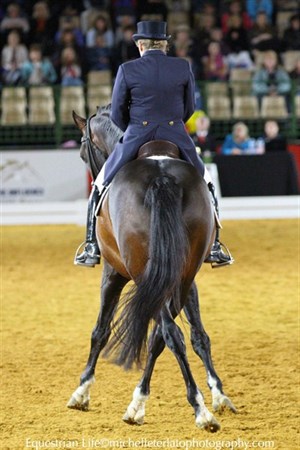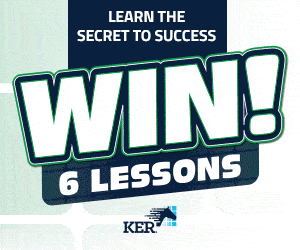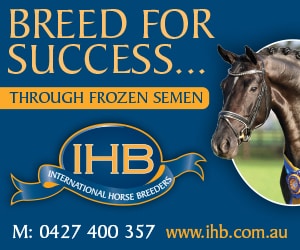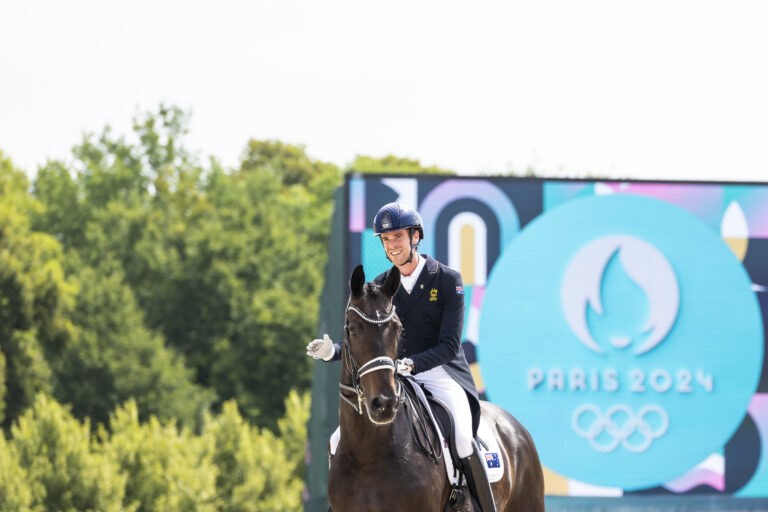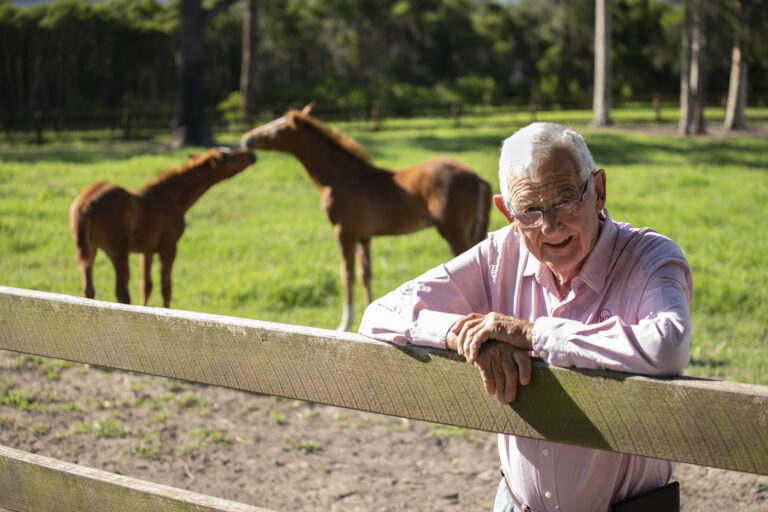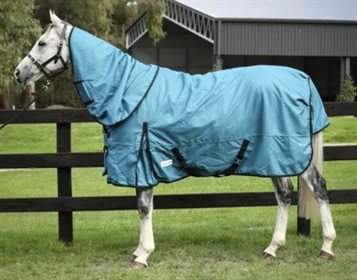Kerry Mack riding Mayfield Pzazz in the half pass.
© Michelle Terlato
In the second in a series about training for an eight, DR KERRY MACK looks at lateral movements in the tests and outlines exercises to improve the quality of the movements with the aim of achieving a higher score.
BY KERRY MACK
THIS IS NOT about teaching the movements but about building better quality in the movements. I am presupposing that the horse is familiar with the movements discussed. The lateral work starts with leg yield at Novice, with the all-important shoulder in, travers and renvers at Elementary, and the half-passes from Medium and above. The horse moves forwards and sideways. In all the lateral work, even at sitting trot, make sure that you are on the correct diagonal so that the aids are given with the correct timing. (if you don’t understand this, please refer back to my blog on sitting trot).
There are fundamental principles in training for the high marks. The training scale gives us a guide. Rhythm is the first thing on the training scale, then suppleness (which includes bending, and whether the activity goes through the whole horse), contact (including the stability of the contact), impulsion, straightness and collection. So you must be able to keep the rhythm absolutely regular throughout each pace, into the laterals and throughout the movement and back to the straight work. It is very common to see the rhythm slow down and the steps become smaller in the lateral work. You must train so that the horse can balance in the forwards and sideways movements without slowing and shortening the stride.
Collection must be developed to a degree appropriate for the level in which you are competing. For instance, there should be a higher degree of collection shown at Prix St George than at Advanced, even though the movements in the test are similar. Of course, to get the high marks the test must be ridden accurately. Make sure you ride on the markers and take care to ride into the corners. Once again, the higher the level, the deeper you ride into the corners. So when you are training, be pedantic about accuracy and corners. If it is not accurate at home it will not be accurate at the competition.
To get an eight in any movement the basic pace must be worth an eight. For example, in the trot leg yield, the trot must be worth an eight. So in training any lateral, one must keep the horse moving actively forward. Keep plenty of energy, pay attention to the rhythm so the tempo does not speed up (running) or slow down. The judge is watching for these changes in rhythm and tempo and you will lose marks if rhythm and tempo are not maintained. It is very common that rhythm will slow as the horse starts to do a lateral movement, and frequently the steps also get shorter. He does this partly to keep his balance in the more difficult lateral movement. So, in training, we must ensure that he learns to keep his balance with the same length and rhythm of the steps as the basic straight trot. This applies to any lateral movement. In all the following exercises, keep paying attention to the rhythm, tempo and energy.
Start simply by varying the length of the steps. You might at first allow that he will make the steps shorter so he finds his balance in the movement. You must not accept that the rhythm slows. Allow the shorter steps so he finds his balance and gradually vary the length so he learns to find balance as the steps get longer and shorter. Remember, you can’t force him to balance, although it is possible to cheat and allow him to balance on your hands with a too strong a contact. Self-carriage will be lost if you allow this, so when you can vary the steps, test out the self-carriage by giving first the inside reins. At first this will be difficult and momentary, but as his balance improves it will get easier and be able to be more prolonged. Then you can even try giving both reins and see if he is in self-carriage and waiting on your seat.
Improve the horse’s balance by varying the angle and varying the extent of sideways movement. Improving the balance is a key goal of training. While training any movement, think about how you can take the forward energy and make the steps more expressive and higher and with the balance rocking back on to the hind legs. Ensure that you are taking responsibility for your own balance and using your position to put a stable frame around the horse to allow stability and lightness in the contact. He must not balance on the rein but must feel confident to seek the contact. It is extremely helpful to stay on the correct diagonal, even in the sitting trot. Just a slight up-down so that you apply your aids in the correct rhythm. Legs breath the aids into the horse’s rhythm. Legs gently pulse on as the inside hind leg pushes and relaxes again.
The first lateral movement in the tests is the leg yield in the Novice tests. The purpose is to show that the horse gives to the leg and moves forwards and sideways away from the leg. The leg yield is preparation for the other lateral movements. Collection is not required. The shoulder must lead. Put in the energy and rhythm. Vary the length of the steps and vary the angle, vary the amount of sideways movement. Do not allow the rhythm to change.
The shoulder in is an extremely important movement. It was invented by de la Gueriniere to help develop the collection. In the shoulder in, the horse steps the inside hind leg under the body and pushes. This builds carrying capacity. In training, you must keep energy and tempo. Most horses will try to slow down and make the steps slower to avoid carrying weight behind. In training you must maintain energy and tempo. A great exercise is to start by balancing and collecting the trot in the corner, then go straight along the long side and go medium trot, then bring the shoulder in and do the shoulder in and keep the medium trot. Then go forward and straight still in medium. You can go out of shoulder in along the long side, or vary it by going straight out on the diagonal that is the line of the angle of the shoulder in. Later on, do the same thing on the diagonal lines, for example, FXH and KXM, medium trot, half-pass in the medium trot, back to medium. Don’t let him run. Think longer, slower strides.
You can also then help him learn to improve his balance by varying the length of steps within the shoulder in, longer steps, shorter steps (with activity). Check that he is in self-carriage by giving the rein within the movement. First the inside rein, don’t allow the angle or the rhythm to change. Then see if you can gently soften both hands.
Travers is mainly about the horse’s ability to bend in the body. It is not so much about collection. The principles are the same. Insist on plenty of energy. Longer steps. Then vary the steps. The horse should look straight up the long side, with his quarters inside, bent around your inside leg. You should sit balanced in the middle of his back, with a tendency toward pushing on the inside leg. Ensure that you can use the outside leg to press the quarters in without changing your balance and sitting heavier on the outside. This becomes even more important in the half-passes. You should sit in the direction you want him to go. Half-passes are again a collected movement. The reason it is absolutely important that the shoulders lead is so that the hind leg is carrying the weight. The hind leg must step under the body of the horse if it’s to carry weight. If the quarters lead, the hind leg is not stepping under the body of the horse. Try starting the diagonal line in medium trot and then make the half-pass. Keep the activity and the length of the steps. When the horse is able to balance in this very active trot, you can start to vary the trot within the half-pass. Longer steps, shorter steps, keeping the angle and the contact the same.
If the horse loses the balance you can help him find a way to balance by going forward in shoulder in parallel to the long side. When the trot is for an eight, go back to half-pass. You will find this is really helpful. Any time in training that the half-pass loses the quality in the pace, or if you lose the bending, or lose the position – that is, that the shoulder is not leading – go to shoulder in, refresh the trot and continue the half-pass. It may only take a few steps shoulder in to correct the problem. You shouldn’t let him continue in poor form as the more he does it the more you train his nervous system to do the wrong thing. Correct it quickly and in rhythm. Don’t correct it with a handbrake turn.
Another exercise is to go down the long side in an active trot, do a small (six-to-eight metre) half-circle with a lot of bend and then go very sideways in a steep leg yield. This gets the legs crossing really well. Then allow the sideways to be less steep but stay on he same diagonal and flip the bend around the inside leg into half-pass. Keep the energy.
This leg yield to half-pass can then go back to leg yield. Leg yield off the left leg into half-pass right and back to leg yield left. This is preparation, too, for the counter changes of hand.
Another exercise is to go from half-pass right and keep the same bend but go to the opposite diagonal into right leg yield. This is like a zigzag where you don’t change the bend. The leg yield is easier so you do as much half-pass as you can keeping the rhythm and energy in the steps, and if he slows or shortens refresh the trot in the leg yield, and next carry that energy and rhythm back into the half-pass.
Most of these exercises can be done tactfully in canter as well.
Remember the basics of learning theory, ask little and reward often. Work with five to seven repetitions, but don’t make him bored.
Have fun.
Kerry
READ THE LATEST NEWS ARTICLES HERE

